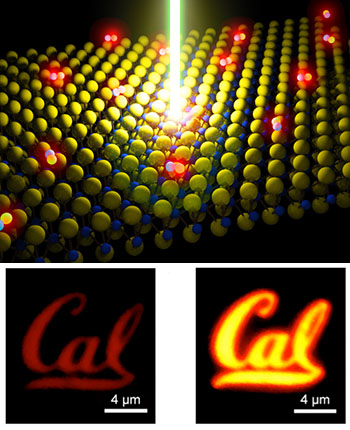
Top: Artist’s rendering of a laser exciting a 2-D molybdenum disulfide (MoS2) monolayer to excite photoluminescence (red dots). [Image: Der-Hsien Lien] Bottom: Treatment of MoS2 monolayer semiconductor with an organic “superacid” boosted emitted light by two orders of magnitude (right panel) compared with untreated semiconductor (left panel). [Image: Matin Amani]
Monolayer semiconductors might become great components of flexible LED displays and photovoltaic cells, if only the fragile materials weren't so prone to defects. Researchers at two U.S. laboratories have figured out how to boost the photoluminescence quantum yield of one such monolayer substance by dipping it into a high-strength acid (Science, doi: 10.1126/science.aad2114).
The team, based at the University of California at Berkeley and Lawrence Berkeley National Laboratory (LBNL), USA, experimented with molybdenum disulfide (MoS2), a type of material known as a transition metal dichalcogenide. Bulk MoS2 resembles graphite and forms super-thin (0.7-nm thickness) layers held together by van der Waals forces. However, their fragility makes them prone to lattice defects, which in turn give the monolayers low photoluminescence quantum yields—a measure of the radiated photons versus the number of electron-hole pairs within the material.
Fortunately, monolayer dichalcogenides respond well to techniques that make them more passive, or shielded from environmental factors that cause defects. The U.C. Berkeley–LBNL team, led by doctoral students Matin Amani and Der-Hsien Lin and postdoctoral fellow Daisuke Kiriya, immersed MoS2 samples in a 100 °C bath of a non-oxidizing “superacid,” a substance with more acidity than pure sulfuric acid. After drying the samples in a nitrogen atmosphere, the researchers excited the semiconductor flakes with illumination from a 514.5-nm argon-ion laser.
The team found that the monolayers exhibited maximum photoluminescence quantum yield of 95 percent or greater at low pump intensity. A microscopic examination showed that the superacid treatment did not change the bulk surface morphology of the samples.
OSA Fellows Xiang Zhang and Eli Yablonovitch co-authored the report on the experiments, which took place in the Berkeley laboratories of professor Ali Javey. The team included members from National Taiwan University, the University of Texas at Dallas and the U.S. Army Research Laboratory.
